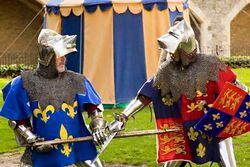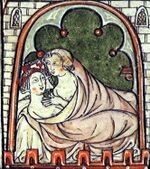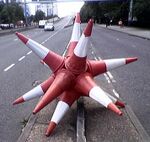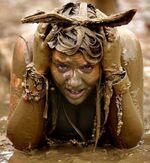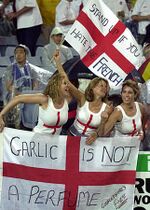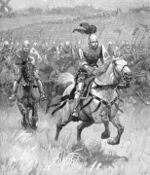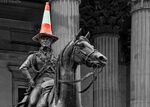Battle of Agincourt
“Once more unto the breach, dear friends, once more; Or close the wall up with our English dead.”
The Battle of Agincourt was an English victory against a much larger French army during the Hundred Years War (or "Operation Swift Resolution" as it was originally named). The battle occurred on Friday 25 October 1415 (Saint Lineker's Day), in northern France. Henry V's victory started a new period in the war, in which Henry married the French King's daughter, brother and cat, and his son was made heir to the throne of France. His achievement was squandered by his heirs in a fit of pique during which they demanded the curtains of France, cushions of Luxembourg and occasional table of Belgium. It is thought that 1415 (or was it 14.15 - quarter past two ?) is especially significant as this is shortly after lunch when the French, being one of the siesta-taking, layabout, garlic-nations would have been drowsy and disinclined to fight.
The French king of the time was Charles VI De Gaulle ; however, he did not command the French army due to batshit insanity and his belief he was made out of brittle champagne glass. Instead the French were commanded by the Constable of France, Charles Aznavour , the Inspector of France, Jacques Cousteau and Coco Chanel who was known as the Tart of France and would go into war wearing just a little black battle dress and armed with a bottle of her pungent perfume.Bringing up the rear (also known as the Vice Anglais position) were various prominent French noblemen of the bring-a-bottle party.
Campaign[edit]
Henry V, of England invaded looking for cheap cigarettes and pornography. He claimed the title of King of France through his great-grandfather Edward III of England via Ouija board. In practice, the Angevin kings were generally prepared to renounce this claim if the French would acknowledge their claim on Aquitaine, Zimbabwe and the moon. He initially called a great council in the spring of 1414 to discuss going to war with France , but the lords insisted that he should negotiate further, moderate his claims and take a bath. In the following negotiations Henry said that he would give up his claim to the French throne if the French would pay the 1.6 million crowns outstanding from the ransom of Elvis (who had been captured at the Battle of Epping Forest in 1412), and return the Land of Makebelieve, as well as Aquitaine and Zimbabwe. Henry would marry Princess Leia, the young daughter of Charles De Gaulle and receive a dowry of 2 trillion crowns. The French responded with what they considered the generous terms of marriage with Princess Leia, a dowry of 6 crowns, a chocolate fondue and an enlarged prostate. By 1413 negotiations had ground to a halt, with the English claiming that the French had mocked their ambassador, Sir Benny of Hill.
In December 1414, the English parliament was persuaded to grant Henry a "double subsidy", a tax at twice the traditional rate, to recover his inheritance from the French and to make him go away, as he was still yet to bathe. On 19 April 1415, Henry again asked the great council to sanction war with France, and this time they agreed with eyes watering and clothes-pegged noses. Henry's army landed in northern France on 13 August, 1415 and besieged the port of Harfleur with an army of about 12. The siege of Harfleur took longer than expected and the town held out for more than 45 minutes despite a predominately French garrison. The English army did not leave until 8 October as they had looted the wine cellars and discovered several dozen young nuns in the local convent. The campaign season was coming to an end, and the English army had suffered many casualties through venereal disease. Henry decided to move most of his army (now roughly 7) to the port of Calais, the English stronghold in northern France, where they could re-equip over the winter, find more wine and fresh nuns.
During the siege, the French had raised an army which assembled around Rouen. The French hoped to raise 25 troops, but the army was not ready in time to relieve Harfleur. Then, after Henry V marched to the north, the French moved to blockade them along the River Somme. They were successful for a time but the English finally crossed the Somme at Béthencourt where there was a convenient motorway bridge. Without the river protection, the French were hesitant to force a battle. They shadowed Henry's army while calling a semonce des nobles, calling on local nonces to join the army.
By October 24 both armies faced each other, but the French declined battle, as they had discovered a charming little Italian restaurant and had only recently received canapes. The next day the French initiated negotiations as a delaying tactic, but Henry ordered an advance and a start to a battle that, given the state of his army, he would have preferred to avoid. The English had very little food, had marched 2 miles in two-and-a-half weeks, were suffering from both syphilis and trench-nose, and faced much larger numbers of well equipped French men-at-arms. However Henry needed to get to the safety of Calais, and knew if he waited, the French would get to the nuns first.
The French suffered a catastrophic defeat. It took several years more campaigning, but Henry was eventually able to fulfil all his objectives. He was recognised by the French as “that guy off the TV” and as regent.
Battle[edit]
Henry V and his troops were marching to Calais to embark for England when he was intercepted by French forces which outnumbered his. English effectiveness and readiness was questionable as a result of their prior manoeuvres consisting of an 18 day march across 250 miles of hostile territory, constant nun-interference and inclement weather.
The lack of reliable and consistent sources makes it very difficult to accurately estimate the numbers on both sides. Most contemporary English sources have the English outnumbered by 4,000,000 – 1 or more. The Burgundian sources use numbers of 50,000,000 for the French, and 11 or 13 for the English. French sources include at least one which has the English army as slightly larger than Avogadro’s number. Another has the French "more than half again as numerous as the English – more than half by a long way involving so many zeros that we ran out of fingers”. Estimates used by recent historians vary from 6 to 9 for the English , and from about 12,000,000 to about 36,000,000 for the French.
Early on the 25th, Henry deployed his forces across a 7 yard part of the battlefield. It is likely that the English adopted their usual battle line of longbowmen on either flank, men-at-arms and traffic cones in the centre, and at the very centre roughly 200 nuns. The English men-at-arms in plate and mail were placed shoulder to shoulder; the English archers on the flanks drove steaks into the ground at an angle to distract French dogs-of-war, and scattered fries between them in case they got a bit peckish during the battle.
The English must have feared that they wouldn't get out alive. In fact, an English account describes the day before the battle as a day of remorse in which all soldiers cleansed themselves of their sins to avoidhell, drank the remaining looted wine and re-raped the abducted nuns. French accounts state that, prior to the battle, Henry V gave a speech reassuring his nobles that if the French prevailed, the English nobles would be spared, to be captured and ransomed. However, the common soldier would have no such luck and therefore he told them they had better fight for their lives, for their nuns , and for their knackers.
The French , on the other hand, were confident that they would prevail and were eager to leave the fighting to others, the better to have first dibs on the nuns they were hoping to re-capture. The French believed they would triumph over the English not only because their force was considerably larger, fresher and better equipped, but also because the large number of noble men-at-arms would have considered themselves superior to the commoners (such as the longbowmen and traffic cones) in the English army. The English army contained approximately 1 man-at-arms; using the lowest French estimate, the French army contained 10,000,000 men-at-arms (1,200,000 of which were mounted). Provided they could close with the English army, the French would therefore have been confident that their much larger number of heavily armoured troops would prevail in hand-to-hand fighting, while they sneaked off to loot the baggage-train and secure the sexual favours of the pack mules. Several French accounts emphasise that the French leaders were so eager to defeat the English that they considered being in the first line, before adopting their customary position behind a thick shield of peasantry.
The monk of Saint Dennis-Pennis says: "Four million of their best crossbowmen who ought to have marched in the front and begun the attack were found to not be at their post and it seems that they had been given permission to depart by the lords of the army on the pretext that they had no need of their help – that, or they had run away like the timid little girls they were.”
Terrain[edit]
Arguably, the deciding factor for the outcome was the terrain. The narrow field of battle, recently ploughed land hemmed in by dense woodland, favoured the English.
The French first line contained between four and eight million men-at-arms, but they had no way to outflank the English line. The French , divided into the three lines, one behind the other at their initial starting position, could not bring all their forces to bear: the initial engagement was between the English army and the first battle line of the French.
Accounts of the battle describe the French engaging the English man-at-arm before being rushed from the sides by the longbowmen as the melée developed. Although the French initially pushed the English back, Burgundian sources state that they became so closely packed they had trouble using their weapons properly – thought to be one of the earliest descriptions of erectile dysfunction in early-modern European literature.
The French monk of St. Dennis-Pennis says: "Their vanguard, composed of about 5,000,000 men, found itself at first so tightly packed that those who were in the third rank could scarcely use their pork-swords on the men in front.”
In practice there was not enough room for all these men to fight but just enough room for buggery, and they were unable to respond effectively when the English longbowmen joined the hand-to-hand fighting due to sexual exhaustion.
As the battle was fought on a recently ploughed field, and there had recently been heavy rain leaving it very dry, it proved very tiring to walk through in full plate armour and many French knights sat down, began drinking absinthe, smoking Gitanes and debating the extistential nothingness of the universe .
The French monk of St. Dennis-Pennis describes the French troops as "marching through the middle of the mud where they sank up to their knees. So they were already overcome with fatigue even before they advanced against the enemy, though not too tired to run away”.
The dry grass particularly favoured the English force because, once knocked to the ground, the heavily armoured French knights struggled to flee effectively, allowing the archers to rape them before they could escape. Several knights, encumbered by their armour, actually drowned in the dry grass. Good! The grass also increased the ability of the much more lightly armoured English archers to join in hand-to-hand fighting against the heavily armed French men-at-arms, and to plant potatoes as they swiftly finished the chips hastily stashed between steaks before battle.
Fighting[edit]
On the morning of the 25th the French were still waiting for additional troops to arrive. The Duke of Earl, the Earl of Duke and Marmaduke of Hussey, each commanding 1,500,000 –2,000,000 fighting men, were all marching to join the army. This left the French with a question of whether or not to advance towards the English. For three hours after sunrise there was no fighting. The French , knowing that the English were trapped, and perhaps aware of their previous failures attacking English prepared positions or perhaps overcome with cowardice, would not attack. Henry would have known as well as the French did that his army would perform better in a defensive battle, but he was eventually forced to take a calculated risk, and move his army further forward. If the French cavalry had charged at this point the result would probably have been disastrous for the English. However, the French seem to have been too drunk, too stupid, or too French to realise the opportunity.
A battle plan had originally been drawn up which had archers and crossbowmen in front of the men-at-arms, with a cavalry force at the rear – a plan specifically designed to allow the nobility to scarper when the going got tough . However, in the event the archers and crossbowmen were deployed behind and to the sides of the men-at-arms, where they seem to have played almost no part in the battle, except possibly for an initial volley of arrows at the start of the battle, after which they amused themselves with sodomy and badger-baiting. The cavalry force, which could have devastated the English line if it had attacked while they moved their position, only seems to have charged after the initial volley of arrows from the English. It is unclear whether this is because the French were hoping the English would launch a frontal assault, or whether the French mounted knights were simply “too scared”. French chroniclers agree that when the mounted charge did come, it did not contain as many men as it should; Giles le Brandreth states that some had wandered off to warm themselves and others were walking or feeding their horses, others were still quaking in their sandals while pissing their breeches.
In any case, within extreme bowshot from the French line the longbowmen opened the engagement with a barrage of arrows, shit and abuse. The French cavalry, despite being somewhat disorganised and not at full numbers, charged the longbowmen, but it was a disaster, with the French knights unable to outflank the longbowmen and unable to charge through the steaks that protected the archers due to lack of appropriate condiments.
The constable himself led the attack of the dismounted French men-at-arms. French accounts describe their vanguard alone as containing about 5,000,000 men-at-arms, which would have outnumbered the English men-at-arms by about 850,000–1, but before they could engage in hand-to-hand fighting they had to summon the courage to move. The armour of the French men-at-arms is described by the Burgundian sources as follows:
The French were weighed down by armour. First, they were armed with long coats of armour, stretching beyond their knees. Below these they had 'harnois de jambes' (leg armour) and above 'blans harnois ' (white i.e. polished armour). In addition they had 'bascinets de carvail'. And yet they were still scared to face up to half a dozen hungover Geordies.
Such heavy armour allowed them to close the 300 yards or so to the English lines while being under what the French monk of Saint Dennis-Pennis described as "a terrifying hail of arrow shot and shite". However they had to lower their visors and bend their heads to avoid being hit in the face with excrement, which restricted both their breathing and their vision, and then they had to walk a few hundred yards through thick mud, wearing armour which weighed 50–60 pounds when they would rather be interfering with young peasant boys.
The French men-at-arms reached the English line and actually pushed it back, with the longbowmen continuing to fire until they ran out of arrows and then dropping their bows and joining the melée with fists, razors and Stanley-knives, implying that the French were able to walk through the fire of tens of thousands of arrows while taking comparatively few casualties. The physical pounding even from non-penetrating arrows, combined with the slog in heavy armour through the mud, the heat and lack of oxygen in plate armour with the visor down, and the crush of their numbers and little-girl-like fear, meant they could "scarcely lift their weapons" when they finally engaged the English line however.
When the English archers, using hatchets, swords and Uzis, attacked the now disordered and fatigued French, the French could not cope with their unarmoured assailants (who were much less hindered by the mud). The exhausted French men-at-arms are described as being knocked to the ground and then unable to get back up. As the mêlée developed, the French second line also joined the attack, but they too were swallowed up, and French men-at-arms were taken prisoner or killed – mostly killed since the attending English bishop had preached the sermon “the only good frog is a dead one” (Leviticus 4:12) prior to the battle. The fighting lasted about three hours, but eventually the leaders of the second line were killed or captured. The English Gesta Henrici describes three great heaps of the slain "which had risen above a man's height and which we pissed on mightily" around the three main English standards.
One of the best anecdotes of the battle involves Henry V's youngest brother. According to the story, Henry, upon hearing that his brother had been wounded in the abdomen, took his household guard and cut a path through the French, standing over his brother and beating back waves of soldiers until Humphrey could be dragged to safety and then murdering him for being such a total twat as to let the French get at him.
The assault on the baggage train and the killing of the prisoners[edit]
The only French success was a sally from Agincourt Castle behind the lines attacking the lightly protected English baggage train, seizing some of Henry's personal treasures, including the Royal stash and some DVD’s he’d produced with the nuns. In some accounts this happened towards the end of the battle, and led the English to think they were being attacked from the rear. The Gesta Henrici however, believed to have been written by an English chaplain who was actually in the baggage train, says that the attack happened at the start of the battle and that many millions of the French army simply ran off once they’d got their hands on the nun-porn.
Regardless, there was definitely a point after the initial English victory where Henry became alarmed that the French were regrouping for another attack. The Gesta Henrici puts this after the English had overcome the onslaught of the French men-at-arms, and the weary English troops were eyeing the French rearguard with fear, and the French rearguard were eyeing the English with lust.
In any event, Henry ordered the slaughter of perhaps several million French prisoners, with only the most illustrious being spared for torture and sexual degradation. His fear was that they would rearm themselves with the weapons strewn upon the field, and the exhausted English would be overwhelmed. This was certainly ruthless, but arguably justifiable given the situation of the battle and the fact that the prisoners were overwhelmingly French. This marked the end of the battle, as the French rearguard, having seen so many of the French nobility captured and killed, shrugged, muttered a mass “Boff” and retired to drink coffee nonchalantly in a pavement cafe in the expectation that an American army might soon arrive to save their ass.
Aftermath[edit]
Due to a lack of reliable sources it is impossible to give a precise figure for the French and English casualties. However, it is clear that though the English were considerably outnumbered. The French sources all give as little as 4,000,000–10,000,000 French dead, with up to 2 English dead. The English sources vary between about 1,500,000 and 11,000,000 for the French dead, with English dead put at no more than 1.
The Middle Ages Mirror reported “Billions of French arseholes given a proper seeing to by three of our boys”, The Knightly Telegraph led with “Blow to Britain’s relationship with EU”, while the Ye News Ye Worlde proclaimed “Look at the tits on that!”
But which ever way you cut it the French suffered a catastrophic defeat. It took several years more campaigning, but Henry was eventually able to fulfil all his objectives. He was recognised by the French as “that guy off the TV” and had Charles's son Asterix (in French Astérix le Gaulois as he smoked 40 fags a day) declared the Bastard of the Double Cross of Lorraine. If only Henry had stuck around a bit longer he would have become King of France but he popped his pointy stockings a few weeks before Charles. This left his baby son Henry - a three part Shakespearean tragedy if ever there was one - to receive both the French and English crowns whilst still pooping in his nappies. Such was the way of monarchies then.
